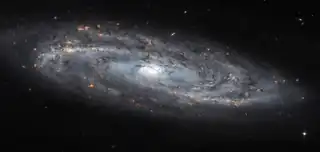| NGC 4100 | |
|---|---|
 Hubble Space Telescope image of NGC 4100 | |
| Observation data (J2000 epoch) | |
| Constellation | Ursa Major |
| Right ascension | 12h 06m 08.602s[1] |
| Declination | +49° 34′ 56.32″[1] |
| Redshift | 0.003582[2] |
| Heliocentric radial velocity | 1,072 ± 6 km/s[2] |
| Distance | 65.1 Mly (20.0 Mpc)[3] |
| Group or cluster | NGC 3992 group[4] |
| Apparent magnitude (B) | 11.7[2] |
| Characteristics | |
| Type | SAbc[2] |
| Mass | 33.3+10.7 −12.7×109[3] M☉ |
| Other designations | |
| NGC 4100, UGC 7095, MCG +08-22-068, PGC 38370[2] | |
NGC 4100 is a spiral galaxy in the northern constellation of Ursa Major. It was discovered by William Herschel on Mar 9, 1788.[5] This galaxy is a member of the NGC 3992 group in the Ursa Major Cluster.[4]
Gallery
 NGC 4100 (SDSS DR14)
NGC 4100 (SDSS DR14) NGC 4100 by GALEX
NGC 4100 by GALEX NGC 4100 by a 32-inch Schulman Telescope at the Mount Lemmon SkyCenter
NGC 4100 by a 32-inch Schulman Telescope at the Mount Lemmon SkyCenter
References
- 1 2 Skrutskie, Michael F.; et al. (1 February 2006). "The Two Micron All Sky Survey (2MASS)". The Astronomical Journal. 131 (2): 1163–1183. Bibcode:2006AJ....131.1163S. doi:10.1086/498708. ISSN 0004-6256. S2CID 18913331.
- 1 2 3 4 5 "NGC 4100". SIMBAD. Centre de données astronomiques de Strasbourg. Retrieved 28 March 2019.
- 1 2 Lianou, S.; et al. (November 2019). "Dust properties and star formation of approximately a thousand local galaxies". Astronomy & Astrophysics. 631: 19. arXiv:1906.02712. Bibcode:2019A&A...631A..38L. doi:10.1051/0004-6361/201834553. S2CID 174801441. A38.
- 1 2 Karachentsev, I. D.; et al. (March 2013). "Anatomy of Ursa Majoris". Monthly Notices of the Royal Astronomical Society. 429 (3): 2264–2273. arXiv:1211.5975. Bibcode:2013MNRAS.429.2264K. doi:10.1093/mnras/sts494.
- ↑ Seligman, Courtney. "New General Catalog Objects: NGC 4100 - 4149". cseligman.com. Retrieved 28 March 2019.
External links
 Media related to NGC 4100 at Wikimedia Commons
Media related to NGC 4100 at Wikimedia Commons
This article is issued from Wikipedia. The text is licensed under Creative Commons - Attribution - Sharealike. Additional terms may apply for the media files.